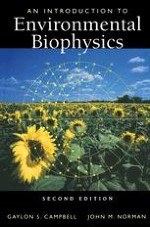1998 | OriginalPaper | Chapter
Water Vapor and Other Gases
Authors : Gaylon S. Campbell, John M. Norman
Published in: An Introduction to Environmental Biophysics
Publisher: Springer New York
Included in: Professional Book Archive
Activate our intelligent search to find suitable subject content or patents.
Select sections of text to find matching patents with Artificial Intelligence. powered by
Select sections of text to find additional relevant content using AI-assisted search. powered by
Terrestrial organisms live in a gaseous medium composed mostly of nitrogen and oxygen. Water vapor is present in varying amounts, and carbon dioxide and other gases, in trace amounts. Organisms exchange oxygen, carbon dioxide, and water vapor with their surroundings. Carbon dioxide is a substrate for photosynthesis and oxygen is a product; while oxygen is a substrate for respiration and carbon dioxide is a product. Exchange of these gases with the environment is therefore a requirement for life. Water vapor almost always moves from the organism to the environment. The humidity of the organism is near 100 percent, while the surroundings are nearly always much drier. The organism must remain in a highly hydrated state in order for biochemical reactions to occur, so the constant loss of water is a threat to survival, and frequent access to liquid water is a necessity for most terrestrial organisms. The intake of liquid water and the loss of water vapor to the environment are usually the most important components of the water budget of an organism.
